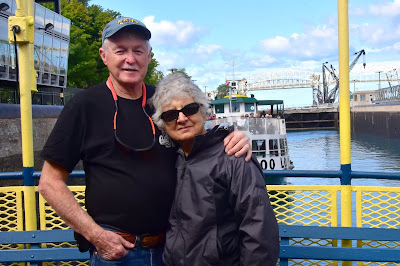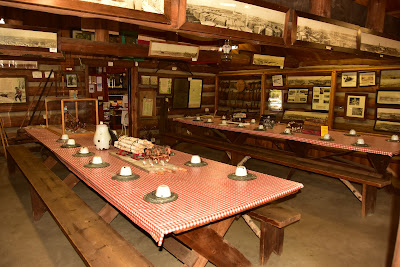But that's where the superlatives end. Beginning with that somewhat obscure movie starring Christopher Reeve and Jane Seymour, "Somewhere in Time," which was filmed on Mackinac Island in and around the Grand Hotel in 1980, tourism to the island has skyrocketed. Except skyrocketing tourism doesn't exactly give a person a correct mental image of an island that is simply mobbed with tourists. The harbor is mobbed with arrivals and departures. The restaurants are ceaselessly mobbed no matter what the hour. The T-shirt shops, of which there are many, are mobbed to the point of being inaccessible. The bike rental businesses are mobbed. The horse-drawn scenic tours are mobbed. And lastly, every single street, alleyway, dock, staircase, bike lane, and sidewalk is mobbed with mobile traffic of some sort.
And that's not all. Because people bring their own bikes to Mackinac, and thousands of others rent bikes, the very streets are mobbed with bikes of every description. There are fat-tired bikes and thin-tired bikes and bicycles built for two and bikes hauling trailers full of children and solitary bikers and whole families on bikes and romantic couples dating on bikes and countless bike racks hugging the roadsides that are chock full of bikes no one wants to be riding just then.So, what have I missed? Oh, I know. In paragraph two I mentioned the horse-drawn carriages or wagons that meander around the island giving tours of a variety of lengths to folks like us who would like to have the history and cultural aspects of the place related to them by someone who lives and works there. If you want to pay the minimum for this service, you can hire a modern-looking wagon that can accommodate perhaps thirty people at a time. The conveyance is not very pretty, rides on rubber tires, and usually looks a bit tired and shoddy. If you want a more intimate ride that holds, for instance two couples or four individuals, you can pay more money and hire a more comfortable livery that looks like something from the nineteenth century. Each of these are pulled by a matched pair of horses, though the larger wagon has larger horses as you might expect.
Concetta and I opted for the more expensive, more intimate, carriage that was commanded by an 18-year veteran of the carriage-driving trade whose name was Tom. We shared the carriage with Bob and Kathy from Wisconsin who didn't say an awful lot, but that was okay because it allowed me to barrage Tom with an endless series of questions about his job, the horses, the passing scenery, and anything else that crossed my mind that required explanation.And that brings up the subject of horses. In addition to all the other beings vying for supremacy on the highways and byways of Mackinac, the ubiquitous horse holds a substantially prominent place. I never did quite understand just how many carriages and wagons were plying the island's roads at any given hour, but Tom told us that his "small" company had 30 horses and his company's competitor had ten times that many. So there are something like 330 horses on the island. Keeping in mind that the horses are usually found in groups of two, that's a lot of wagons and carriages competing for space on the narrow streets of Mackinac. I suppose I should mention that motorized vehicles have been forbidden since the 1890s. Even the trash collector on Main Street has a horse-drawn wagon.
So, now that you've read the foregoing rant you probably think we didn't enjoy ourselves. Well, you'd be partly right. Concetta and I just hate sharing our space with a crush of humanity under any circumstances. Noisy, jostling, situations are just not the optimum for a couple of solitude seekers like us.On the other hand, there are a million things that can be favorably said about Mackinac Island. First of all, every darn thing you see in every direction is either historical, architecturally impressive, or cute as hell. You have the main part of town that abuts the harbor and is just filled end to end with brightly-colored, and cleverly decorated shops. Up and away from the main part of town are a number of Queen Anne-style Victorian houses that are immaculately kept, and most sit nestled in gardens that just make you want to break from your tour and go sit among the blazing borders of flowers. Then there are all the historic points of interest, not the least of which is Fort Mackinac that dates to the American Revolution when the Fort was established by the British.
After our carriage tour was over, and after we rewarded ourselves with some delicious ice cream, we hiked up to the bluff overlooking the town whereon the one-time British stronghold was located. We took the backdoor route rather than climb the steep pathway and stairs to the front door, which is what you should do if you have any mobility problems. My wonky knees appreciated the longer route. Ask the ticket agent at the foot of the path to the fort for directions to the rear entrance.
Once at the top of the bluff, we dodged a couple of horse-drawn wagons, then presented ourselves at the back gate where tickets were also being sold. Having already purchased our tickets at the front entrance, I presented our proof to a girl-guide who was standing near the ticket booth. But she shook her head and said, "that's not my job." We were rather dumbfounded, but recovered quickly. We just told her thanks, and walked right through the ticket aisle and continued up the path to the fort's rear entrance. No one said anything from the booth, and no one came after us. Considering that it cost $27.00 dollars to enter, we thought their lack of diligence odd, but maybe we just looked super honest.And then for the next 90 minutes we visited most of the buildings, photographed everything like crazy, and even watched a trio of "soldiers" demonstrate how 18th century soldiers loaded and fired a rifle (or smooth bore, I couldn't tell which). I was rather impressed with the quality of the reproduced decor for all the military buildings, as well as the care that had been taken to recreate and maintain the buildings themselves. There was a barracks, a hospital, a sutler's store, a quartermaster's storehouse, a bath house (yes soldiers took baths at Mackinac), personal quarters for the officers, a childrens' space, several block houses, and a few others we didn't get to.
The actual history of the fort is pretty interesting. The British established the fort between 1779 and 1781. When the British lost the revolution, America became the owner. But when war broke out again between England and the U.S. in 1812, the British secretly landed their troops on the north side of the island, placed canons on the high ground overlooking the fort, and forced the defenders at the fort to surrender when they learned that they were greatly outnumbered. Two years later the Americans tried to push the British off the island, but they were soundly defeated in the only battle ever fought there.In December of 1814 the war was over. With the peace came a restoration of ownership of Mackinac Island to the United States. Soon after, John Jacob Astor established the American Fur Company's northern department headquarters on Mackinac Island and by the 1820s the fur trade was flourishing. Furs from the company's winter camps in Illinois, Michigan, Wisconsin, and Minnesota flowed to Mackinac every summer. On Mackinac Island's Market Street, the furs were counted, sorted, and baled for shipment to the East Coast and Europe. Millions of dollars worth of furs passed through Mackinac Island in the 1820s.
All this history stuff is intensely interesting to the Happy Wanderers. But by the time we had toured main street, hiked up to the top of the bluff, and then toured the large military site, we were getting a little footsore. We had planned on hanging around until dinnertime, then visiting a dining room that we had heard about while on our carriage tour, but once we got back to the city we opted instead to jump on the ferry and go back to our waiting shuttle. After a comfortable boat ride back to the mainland, and the shuttle back to the camp, we spent the rest of the evening in the wonderful solitude and quiet of our home on wheels, away from the Madding Crowd. Sometimes enough is just enough when it comes to touristy hot spots.So, the question is, would we return to Mackinac Island someday. Yes, I think we would, but we'd have to target the off season for our visit. We definitely would avoid Labor Day weekend, that's for sure. There's just way too many people there in too small a space for our tastes. But hey, on the positive side, after much searching through a variety of shops, I finally managed to find a 100% cotton Mackinac Island t-shirt that I liked. AND, we had just a terrific sandwich at a Market Street sandwich and ice cream shop. I was totally surprised by that bit of luck.
Since we're here for yet another day, tomorrow we plan to pack up the rig, stay on the mainland, and go downtown here in Mackinaw City and see if we can find a few interesting things to see and do. Concetta saw a sign for a nautical museum that should be interesting. Also, on our way to this camp, after our harrowing adventure on the bridge, we passed a frontier fort operation that perhaps we can find our way back to. At any rate, stay tuned as the Happy Wanderers are on the prowl for more adventure. And when you are out their on the two-lanes, we wish you happy travels and exciting adventures.
















































